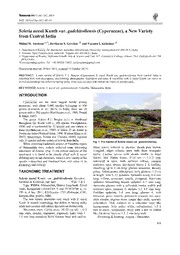Table Of ContentTaiwania 60(4):181‒182, 2015
DOI: 10.6165/tai.2015.60.181
Scleria neesii Kunth var. gadchiroliensis (Cyperaceae), a New Variety
from Central India
Milind M. Sardesai (1,*), Ravikiran S. Govekar (2) and Vasanta I. Kahalkar (3)
1. Department of Botany, Dr. Babasaheb Ambedkar Marathwada University, Aurangabad-431 004 (M.S.) India.
2. National Tiger Conservation Authority, Nagpur-442 402 (M.S.) India.
3. Department of Botany, Mahatma Gandhi Arts & Science and Late N.P. Commerce College, Armori, Dist. Gadchiroli-441 208
(M.S.) India.
*Corresponding author: Tel: +91-88050-75007; [email protected]
(Manuscript received 20 July 2015; accepted 15 October 2015)
ABSTRACT: A new variety of Scleria P. J. Bergius (Cyperaceae) S. neesii Kunth var. gadchiroliensis from Central India is
described here with description, line-drawing, photographic illustration and notes. It resembles with S. neesii Kunth var. neesii in
overall morphology but differs in having milky white nuts covered with ribbon like hairs on distinct stalk.
KEY WORDS: Scleria, S. neesii var. gadchiroliensis, Vidarbha, Maharashtra, India.
INTRODUCTION
Cyperaceae are the third largest family among
monocots, with about 5,460 species belonging to 106
genera (Govaerts et al., 2013). In India, there are 38
genera and ca 580 species (Kartikeyan et al., 1989; Prasad
& Singh, 2002).
The genus Scleria P.J. Bergius (s.l.) is distributed
throughout the World with c. 250 species (Goetghebeur,
1998) and is represented by 32 species and one variety in
India (Karthikeyan et al., 1989) of which 27 are found in
Peninsular India (Wadood Khan, 1998; Wadood Khan et al.
2007). Interestingly Verma and Chandra (1990) reported
only 23 species and one variety of Scleria from India.
Fig. 1. The habitat of Scleria neesii var. gadchiroliensis.
While exploring Gadchiroli district of Vidarbha region
of Maharashtra state, authors collected some interesting Basal leaves reduced to sheaths; sheath pale brown,
specimens of Scleria. (Fig. 1) On critical analysis of the 3-angled, edges villous, apex with three triangular
specimens it is found to be closely allied with S. neesii teeths. Cauline leaves with sheath similar to basal
differing only in nut characters. Hence a new variety of the leaves; leaf blades linear, 5–15 cm × 1.5–3 mm,
species is described and illustrated here, with notes on its narrowed at apex, both surfaces villous, margins
phenology and ecology. scabrous, apex obtuse. Involucral bracts 2–4, leaflike,
sheathing, up to 5 cm long; glumes setaceous, densely
TAXONOMIC TREATMENT pilose. Inflorescence subcapitate, laxly globose, 1–3 cm
in length, with 5–13 spikelets. Spikelets ovoid, 4–8 mm
Scleria neesii Kunth. var. gadchiroliensis Govekar, long, villous, unisexual, sessile, elongated. Staminate
Sardesai & Kahalkar, var. nov. Figs. 2 & 3 spikelets (resembling female spikelet) 4–7 mm long;
Type: INDIA: Maharashtra, District Gadchiroli, Tehsil staminate glumes with a yellowish brown midrib and
Aheri, Kotagudam (19°6′03′′65 N and 79°56′38′′00 E, ca. scabrous apex; stamens 3, anthers 1.3–1.5 mm long.
150 m, 4 Sep. 2011, R.S.Govekar 1711 (Holotype, CAL; Pistillate spikelets 5–8 mm long; glumes 4, with
Isotypes, BSI, BAMU, MH). brownish green midrib, pubescent towards the apex;
The new variety resembles very much with S. neesii style slender; stigmas three, longer than style, sparsely
Kunth in overall morphology but differs in having milky puberulous. Disk reduced to a columnar stipe like
white nuts covered with ribbon like hairs on distinct stalk. hypogynium. Nuts milky white, subspherical, 1.5–2
Rhizomes short. Culms erect, 10–20 cm tall, 1.0–3 mm in diam., tuberculate, shiny with a tuft of ribbon
mm wide, slender, trigonous, copiously hairy with 1– like flat dense hairs on 1.5–2 mm long stalk.
1.5 mm long spreading hairs. Leaves basal and cauline. Flowering & Fruiting: August – December.
181
Taiwania Vol. 60, No. 4
Etymology: Specific epithet is named after the
Gadchiroli district from which the taxon is so far
known to occur.
Fig. 2. Seeds of Scleria neesii (A, B)and its new variety var.
gadchiroliensis (C, D). (A, C SEM)
ACKNOWLEDGEMENTS
The authors are thankful to Dr. M.A. Wadood Khan and
Dr. Sudhir Solanke for their help in identification of the taxon.
Authors are also thankful to Mr. Baburao Dhokne for photo
plates and to Mr. Shankar Mane and Ms. Pratibha Padvi for
the illustrations.
LITERATURE CITED
Goetghebeur, P. 1998. Cyperaceae.In Kubitizki, K., H. Huber, P.
Rudall, P. Stevens & T. Stutzel. [eds.], The Families and
Genera of Vascular Plants. Flowering Plants - Monocotyledons.
Fig. 2. Scleria neesii var. gadchiroliensis. A: Habit. B: Male Vol. 4. Springer-Verlag, Berlin, DE. pp. 141–190.
spikelet. C: Female spikelet. D: Nut.
Govaerts, R., Koopman, J., Simpson, D., Goetghebeur, P.,
Habitat: The variety is so far known to occur in the Wilson, K., Egorova, T. and J. Bruhl. 2013. World Checklist
trapezoid formed by coordinates 19°16′37′′N & 79°56′45′′E, of Cyperaceae. Facilitated by the Royal Botanic Gardens, Kew.
19°16′37′′N & 79°59′00′′E, 19°14′46′′N & 79°56′00′′E and Published on the Internet; http://apps.kew.org/wcsp/ (Retrieved
2015-18-07).
19°14’46′′N & 79°59′42′′E encompassing an area about 15
Karthikeyan, S., Jain, S.K., Nayar M.P. and M. Sanjappa. 1989.
km2. The area falls under compartment No. 259–262,
Cyperaceae. In Florae Indicae Enumeratio: Monocotyledonae.
264–266, 268, 270–273 of Watra Budruk-1, Watra Botanical Survey of India, Kolkata. pp. 71–73.
Budruk-2 of the Devalmari Round of Pranhita Range in Prasad, V.P. and N.P. Singh. 2002. Sedges of Karanataka
Sironcha Forest Division. The forests area is broadly (India). J. Econ. Tax. Bot. Addl. Ser. 21: 1–355.
called as Pranhita Reserve Forests. The variety is Verma, D.M. and Veena Chandra. 1990. The genus Scleria
distributed in low lying flat sandy-loamy areas Berg. in India. Bull. Bot. Surv. India. 32 (1– 4): 57–79.
Wadood Khan, M.A. 1998. Novelties in Cyperaceae of
developed along the periphery of rocky outcrops with
Maharashtra. J. Econ. Tax. Bot. 22 (3): 555–561.
average altitude 150 m. The general vegetation in the
Wadood Khan, M.A., Solanke, Sudhir N. and D.P.
area is scrub-open type Euphorbia mixed forest.
Chavan. 2007. Genus Scleria Berg. (Cyperaceae) in
Paratypes: INDIA: Maharashtra, Gadchiroli District, Watra Peninsular India, rest of Maharashtra and Andaman. J.
Budruk (Pedda Watra), 5 Sep. 2011, R.S. Govekar 1743 (BAMU). Econ. Tax. Bot. 31 (3): 598–612.
182

